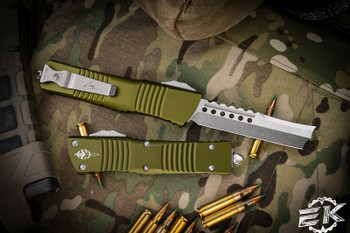Best Blades for a Knife-Only Survival Course
Posted by Clayton on Sep 7th 2017
Since the dawn of time, knives have been used for survival in its most basic form. Although our primal instincts may still be fundamentally the same, we now have much more sophisticated and task-specific blades at our disposal than our ancestors did.
And when it comes to task-specific, the ultimate survival blade is the one that is also the most versatile. Surprisingly, to some, the primary use of such a knife is not hunting. Survival is more about making it out alive in a few days or weeks than living as a hunter/gatherer for protracted periods of time. This definition may affect how you choose your blade, so we’ve outlined a few criteria to consider.
What Am I Looking For?
When it comes to what to look for when choosing a survival knife, the focus is primarily on the blade. High-carbon blade steel is a material of choice for most. For example, the Zero Tolerance 0562CF Carbon Fiber Hinderer. This blade was named Knife of the Year at the 2014 Blade Show.
Stainless steel is also an option if you don't want to spend a lot of time and effort preventing corrosion. A great stainless-steel blade for a survival course is the Microtech Combat Troodon OD Green OTF SE M390 Satin 143-5OD, an out-the-front drop-point blade.
Since the blade can make or break your survival experience, the blade quality is the first concern. However, it is also wise to ascertain whether the handle can hold up under conditions of extreme pressure and shock. Most, if not all, experienced knife-only survivalists prefer to use knives with a fixed blade because they cannot fold back on your hand in a high-pressure, slippery situation. A fixed blade can also handle impact better, for instance when used as a spear. And there are no moving parts that can be damaged.
Versatility
Your survival knife is going to have to double as an axe, spear and even a shovel. It must be sharp enough to whittle sticks, strong enough to chop wood and tough enough to dig wells.
To break it down, there are some basic characteristics you are looking for in your ideal survival knife:
- Hardness (strength)
- Toughness (durability) and Wear Resistance
- Edge (sharpness)
- Stain Resistance (ability to withstand corrosion)
- Compatibility (personal fit)
Hardness
This refers to the strength of the blade and is measured using a system called the Rockwell Scale, which uses the symbol HRC. Kitchen knives generally have an HRC of about 57, but the optimum HRC for a survival knife will be more in the region of 59 or 60.
The harder the knife, the more brittle it becomes, which introduces the danger of the blade snapping or chipping. The softer the blade (lower than HRC 58), the more susceptible it is to dulling and bending. Softer knives may be able to hold an edge for a while, but they require more sharpening than harder blades.
Toughness and Wear Resistance
Your survival knife is going to be doing very un-knifelike things, like digging or cutting wood.
With all the digging, chopping, sharpening and prying you will be doing, your knife will go through some serious abrasion. A knife that is wear-resistant has a good HRC rating, but the materials and the manufacturing process may affect resistance to wear.
Edge
A survival knife that cannot hold an enduring edge is going to cost you effort and energy in sharpening it. Here is where the thickness (or rather thinness) of the blade comes into play. Too thin and you run the risk of folds and chips in the edge. If it’s too thick, you have a blade that requires too much sharpening.
Stain Resistance
Of course, we are all aware that stainless steel is the easiest material to take care of since it is strong and responds well to sharpening. But in terms of a survival knife, it is a little on the soft side. So if you are willing to spend time and effort in caring for your blade, you can invest in a harder steel that provides more satisfaction in the heat of survival.
Compatibility
Personal fit, comfort and ergonomics should always be considered. A reputable knife dealer can provide you with tons of helpful information so that you can ascertain which knife is right for you.

